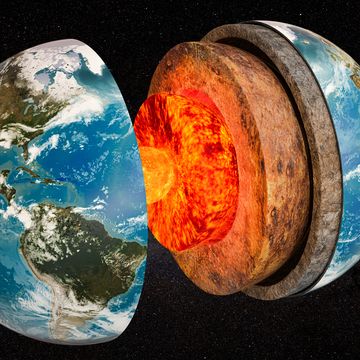The discovery of a debris field comprised of the remnants of the missing Titan submersible marks the tragic end to the rescue effort of the five crew members lost underwater since Sunday, according to an update from the U.S. Coast Guard.
Following news from earlier Thursday—announced by the Coast Guard’s Twitter account—that a debris field had been found about 1,600 feet from the bow of the Titanic by remote-controlled underwater search vehicles (ROVs), the Coast Guard held an afternoon briefing to confirm that the debris field came from OceanGate’s Titan submersible.
“In consultation with experts from within the unified command, the debris is consistent with the catastrophic loss of the pressure chamber,” Rear Admiral John Mauger said during the press briefing. “Upon this determination, we immediately notified the families.”
More From Men's Health

Mauger said that the ROV from the vessel Horizon Arctic first discovered the nose cone of the Titan on the seafloor about 1,600 feet from the bow of the Titanic. Further examination revealed five major pieces of debris from the Titan, including the front end of the pressure hull.
A second, smaller debris field was spotted soon after. That debris field included the rear of the pressure hull, which finalized a totality of the pressure vessel. “This was a catastrophic implosion of the vessel,” Mauger said.
Mauger said that while they cannot determine the exact timing of the failure, the sonar buoys that were dropped to listen for signs of the lost craft did not detect the sounds of any catastrophic failures. Had the craft imploded after the buoys were dropped, they would have picked up the implosion. The location of the debris field is also consistent with the water column in which the Titan lost contact with its host ship on Sunday. All signs point toward a Sunday failure.
The location of the debris field is on a smooth portion of the seafloor that does not contain any Titanic wreckage.
Remote-controlled vehicles will remain on the scene to continue to gather information and map the debris field to “do the best we can to fully map what’s down there.”
The tiny submersible vessel designed to let tourists explore the wreckage of the Titanic, located south of the Canadian coast and east of the northeast United States, lost contact with a support ship roughly 1 hour and 45 minutes into a mission early in the morning of Sunday, June 18. Later that day, the search for the missing Titan—and more specifically, the five people on board the 22-foot-long vessel—began in earnest.
OceanGate, the owner of the Titan, put out a statement thanking the international community for its efforts and saying, “we grieve the loss of life.”
Tim Newcomb is a journalist based in the Pacific Northwest. He covers stadiums, sneakers, gear, infrastructure, and more for a variety of publications, including Popular Mechanics. His favorite interviews have included sit-downs with Roger Federer in Switzerland, Kobe Bryant in Los Angeles, and Tinker Hatfield in Portland.












